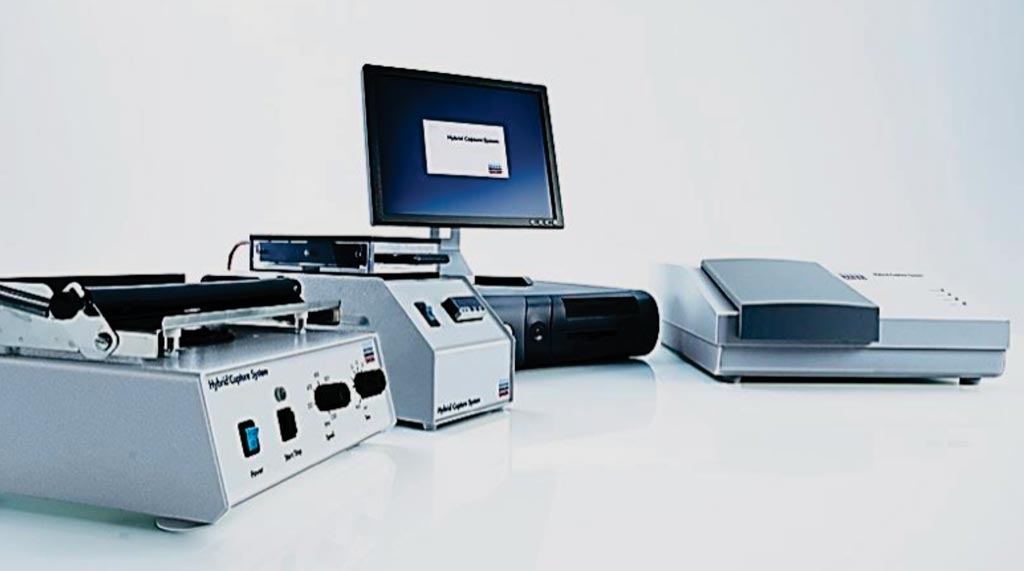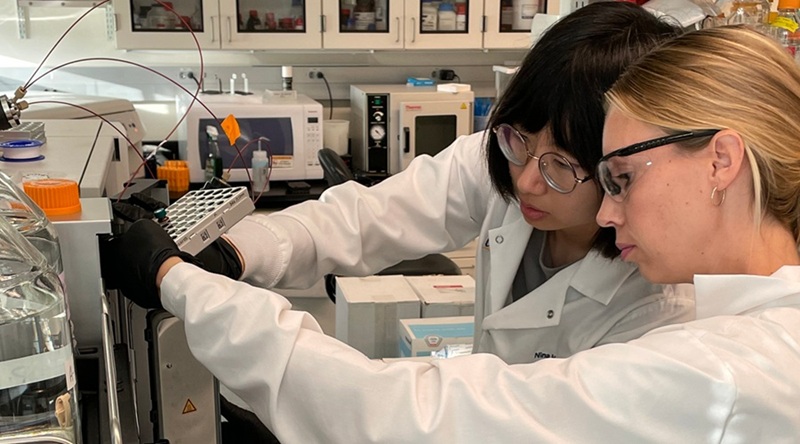HPV Testing Detects More Precancerous Lesions
|
By LabMedica International staff writers Posted on 03 Oct 2017 |

Image: The Hybrid Capture 2 modular system used for processing the digene HC2 HPV DNA Test of human papillomavirus infections (Photo courtesy of Qiagen).
Human papillomavirus (HPV) testing detects a higher number of precancerous cervical lesions than cytology-based Papanicolaou (Pap) smears in a female population including a proportion offered HPV vaccination according to a new study.
Many countries are currently considering switching from classic Pap tests to primary HPV tests for cervical cancer screening, based on the strong evidence linking cervical abnormalities and infection with certain HPV types, and data suggesting that HPV tests detect more high-grade precancerous lesions.
Scientists collaborating with those at the Victorian Cytology Service, Melbourne, Australia) randomized cervical samples from 4,995 women aged 25-64 in Australia, in a 1:2:2 ratio, to be analyzed by either cytology (with HPV testing of low-grade abnormalities), HPV testing with partial genotyping of the virus for the highest risk types HPV16 and 18, and cytology (for participants with other high-risk HPV genotypes), or HPV testing with partial genotyping and dual-stained cytology. In the first screening round of the trial, the scientists assessed the rates of women being referred for further testing and of detection of high-grade cervical intraepithelial neoplasia precancerous lesions (CIN2+).
For liquid-based cytology (LBC) screening and triage testing, ThinPrep was used. For HPV screening and triage testing, both the digene Hybrid Capture 2 (HC2) and Cobas 4800 technologies were used since the objectives of the study included laboratory evaluation of different HPV test technologies. The Cobas 4800 was used for the initial 3,104 (78%) of the total 4,003 HPV-screened women, and HC2 was used for the remainder.
The investigators found that for the cytology group, the overall referral and detected CIN2+ rates were 27/995 (2.7%) and 1/995 (0.1%) respectively; for the HPV testing and cytology group these were 75/1992 (3.8%)and 20/1992 (1.0%) and for the HPV and dual-stained cytology group these were 79/2008 (3.9%) and 24/2008 (1.2%). The team found that, in the first round of screening, detection of CIN2+ was significantly increased with HPV testing as compared with cytology, while referral was non-significantly increased. Adverse events were rare, and the one case of early-stage cervical cancer in the HPV testing plus cytology group was detected as appropriate by screening.
Karen Canfell, D.Phil, a professor of cancer epidemiology and lead author of the study, said, “These findings provide initial confirmation of an improved performance of primary HPV screening compared to cytology screening in settings with HPV-vaccinated populations. These findings support the planned imminent introduction of cervical screening by HPV testing in Australia which will occur at the end of 2017.” The study was published on September 19, 2017, in the journal Public Library of Science Medicine.
Related Links:
Victorian Cytology Service
Many countries are currently considering switching from classic Pap tests to primary HPV tests for cervical cancer screening, based on the strong evidence linking cervical abnormalities and infection with certain HPV types, and data suggesting that HPV tests detect more high-grade precancerous lesions.
Scientists collaborating with those at the Victorian Cytology Service, Melbourne, Australia) randomized cervical samples from 4,995 women aged 25-64 in Australia, in a 1:2:2 ratio, to be analyzed by either cytology (with HPV testing of low-grade abnormalities), HPV testing with partial genotyping of the virus for the highest risk types HPV16 and 18, and cytology (for participants with other high-risk HPV genotypes), or HPV testing with partial genotyping and dual-stained cytology. In the first screening round of the trial, the scientists assessed the rates of women being referred for further testing and of detection of high-grade cervical intraepithelial neoplasia precancerous lesions (CIN2+).
For liquid-based cytology (LBC) screening and triage testing, ThinPrep was used. For HPV screening and triage testing, both the digene Hybrid Capture 2 (HC2) and Cobas 4800 technologies were used since the objectives of the study included laboratory evaluation of different HPV test technologies. The Cobas 4800 was used for the initial 3,104 (78%) of the total 4,003 HPV-screened women, and HC2 was used for the remainder.
The investigators found that for the cytology group, the overall referral and detected CIN2+ rates were 27/995 (2.7%) and 1/995 (0.1%) respectively; for the HPV testing and cytology group these were 75/1992 (3.8%)and 20/1992 (1.0%) and for the HPV and dual-stained cytology group these were 79/2008 (3.9%) and 24/2008 (1.2%). The team found that, in the first round of screening, detection of CIN2+ was significantly increased with HPV testing as compared with cytology, while referral was non-significantly increased. Adverse events were rare, and the one case of early-stage cervical cancer in the HPV testing plus cytology group was detected as appropriate by screening.
Karen Canfell, D.Phil, a professor of cancer epidemiology and lead author of the study, said, “These findings provide initial confirmation of an improved performance of primary HPV screening compared to cytology screening in settings with HPV-vaccinated populations. These findings support the planned imminent introduction of cervical screening by HPV testing in Australia which will occur at the end of 2017.” The study was published on September 19, 2017, in the journal Public Library of Science Medicine.
Related Links:
Victorian Cytology Service
Latest Pathology News
- Rapid Low-Cost Tests Can Prevent Child Deaths from Contaminated Medicinal Syrups
- Tumor Signals in Saliva and Blood Enable Non-Invasive Monitoring of Head and Neck Cancer
- Common Health Issues Can Influence New Blood Tests for Alzheimer’s Disease
- Blood Test Formula Identifies Chronic Liver Disease Patients with Higher Cancer Risk
- Tunable Cell-Sorting Device Holds Potential for Multiple Biomedical Applications
- AI Tool Outperforms Doctors in Spotting Blood Cell Abnormalities
- AI Tool Rapidly Analyzes Complex Cancer Images for Personalized Treatment
- Diagnostic Technology Performs Rapid Biofluid Analysis Using Single Droplet
- Novel Technology Tracks Hidden Cancer Cells Faster
- AI Tool Improves Breast Cancer Detection
- AI Tool Predicts Treatment Success in Rectal Cancer Patients
- Blood Test and Sputum Analysis Predict Acute COPD Exacerbation
- AI Tool to Transform Skin Cancer Detection with Near-Perfect Accuracy
- Unique Immune Signatures Distinguish Rare Autoimmune Condition from Multiple Sclerosis
- Simple Optical Microscopy Method Reveals Hidden Structures in Remarkable Detail
- Hydrogel-Based Technology Isolates Extracellular Vesicles for Early Disease Diagnosis
Channels
Clinical Chemistry
view channel
Online Tool Detects Drug Exposure Directly from Patient Samples
Doctors often rely on patient interviews and medical records to determine what medications a person has taken, but this information is frequently incomplete. People may forget drugs they used, take over-the-counter... Read more
Chemical Imaging Probe Could Track and Treat Prostate Cancer
Prostate cancer remains a leading cause of illness and death among men, with many patients eventually developing resistance to standard hormone-blocking therapies. These drugs often lose effectiveness... Read moreMolecular Diagnostics
view channel
New 15-Minute Hepatitis C Test Paves Way for Same-Day Treatment
Chronic hepatitis C infection affects an estimated 50 million people worldwide and causes around 242,000 deaths each year, largely due to cirrhosis and liver cancer. Although the infection is curable with... Read more
Ovarian Cancer Assay Outperforms Traditional Tests in Early Disease Detection
Globally, ovarian cancer is one of the deadliest cancers affecting women. Traditionally, early diagnosis of ovarian cancer has been challenging. Many ovarian cancers are diagnosed only after they have... Read moreHematology
view channel
MRD Tests Could Predict Survival in Leukemia Patients
Acute myeloid leukemia is an aggressive blood cancer that disrupts normal blood cell production and often relapses even after intensive treatment. Clinicians currently lack early, reliable markers to predict... Read more
Platelet Activity Blood Test in Middle Age Could Identify Early Alzheimer’s Risk
Early detection of Alzheimer’s disease remains one of the biggest unmet needs in neurology, particularly because the biological changes underlying the disorder begin decades before memory symptoms appear.... Read more
Microvesicles Measurement Could Detect Vascular Injury in Sickle Cell Disease Patients
Assessing disease severity in sickle cell disease (SCD) remains challenging, especially when trying to predict hemolysis, vascular injury, and risk of complications such as vaso-occlusive crises.... Read more
ADLM’s New Coagulation Testing Guidance to Improve Care for Patients on Blood Thinners
Direct oral anticoagulants (DOACs) are one of the most common types of blood thinners. Patients take them to prevent a host of complications that could arise from blood clotting, including stroke, deep... Read moreImmunology
view channel
Routine Blood Test Can Predict Who Benefits Most from CAR T-Cell Therapy
CAR T-cell therapy has transformed treatment for patients with relapsed or treatment-resistant non-Hodgkin lymphoma, but many patients eventually relapse despite an initial response. Clinicians currently... Read more
New Test Distinguishes Vaccine-Induced False Positives from Active HIV Infection
Since HIV was identified in 1983, more than 91 million people have contracted the virus, and over 44 million have died from related causes. Today, nearly 40 million individuals worldwide live with HIV-1,... Read more
Gene Signature Test Predicts Response to Key Breast Cancer Treatment
DK4/6 inhibitors paired with hormone therapy have become a cornerstone treatment for advanced HR+/HER2– breast cancer, slowing tumor growth by blocking key proteins that drive cell division.... Read more
Chip Captures Cancer Cells from Blood to Help Select Right Breast Cancer Treatment
Ductal carcinoma in situ (DCIS) accounts for about a quarter of all breast cancer cases and generally carries a good prognosis. This non-invasive form of the disease may or may not become life-threatening.... Read morePathology
view channel
Rapid Low-Cost Tests Can Prevent Child Deaths from Contaminated Medicinal Syrups
Medicinal syrups contaminated with toxic chemicals have caused the deaths of hundreds of children worldwide, exposing a critical gap in how these products are tested before reaching patients.... Read more
Tumor Signals in Saliva and Blood Enable Non-Invasive Monitoring of Head and Neck Cancer
Head and neck cancers are among the most aggressive malignancies worldwide, with nearly 900,000 new cases diagnosed each year. Monitoring these cancers for recurrence or relapse typically relies on tissue... Read more
Common Health Issues Can Influence New Blood Tests for Alzheimer’s Disease
Blood-based tests for Alzheimer’s disease are transforming diagnosis by offering a simpler alternative to spinal taps and brain imaging. However, many people evaluated at memory clinics also live with... Read more
Blood Test Formula Identifies Chronic Liver Disease Patients with Higher Cancer Risk
Chronic liver disease affects millions worldwide and can progress silently to hepatocellular carcinoma (HCC), one of the deadliest cancers globally. While surveillance guidelines exist for patients with... Read moreTechnology
view channel
Machine Learning Models Diagnose ALS Earlier Through Blood Biomarkers
Amyotrophic lateral sclerosis (ALS) is a rapidly progressive neurodegenerative disease that is notoriously difficult to diagnose in its early stages. Early symptoms often overlap with other neurological... Read more
Artificial Intelligence Model Could Accelerate Rare Disease Diagnosis
Identifying which genetic variants actually cause disease remains one of the biggest challenges in genomic medicine. Each person carries tens of thousands of DNA changes, yet only a few meaningfully alter... Read moreIndustry
view channel
Abbott Acquires Cancer-Screening Company Exact Sciences
Abbott (Abbott Park, IL, USA) has entered into a definitive agreement to acquire Exact Sciences (Madison, WI, USA), enabling it to enter and lead in fast-growing cancer diagnostics segments.... Read more



















